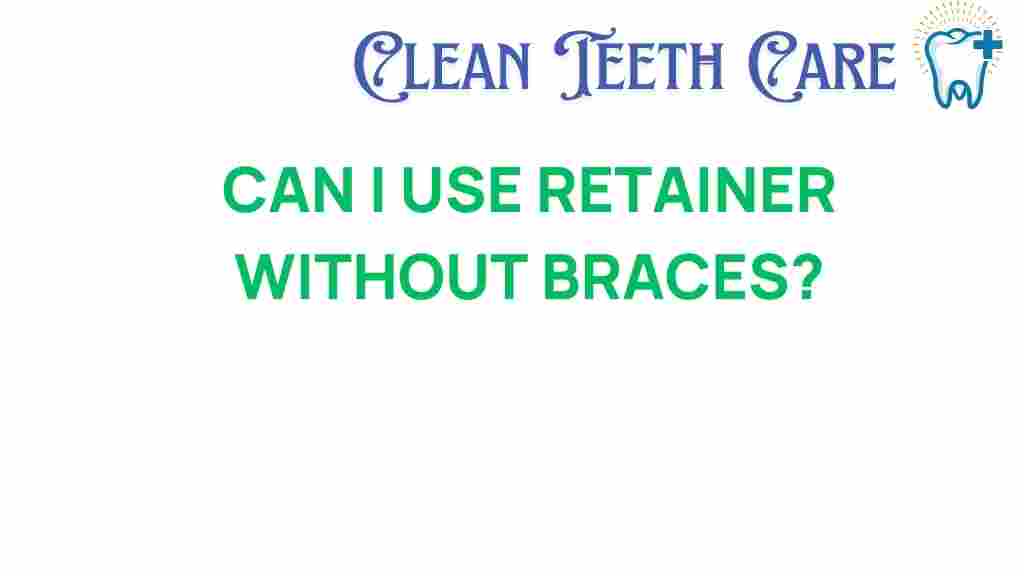Unlocking the Mystery: Can You Use a Retainer Without Braces?
When it comes to orthodontics and maintaining dental health, the conversation often revolves around braces. However, a lesser-known tool in the journey to achieving perfect teeth alignment is the retainer. Many people wonder, “Can you use a retainer without braces?” In this article, we’ll explore the functionality of retainers, their role in smile enhancement, and the types of dental treatments available, including removable retainers. Read on to uncover the mystery of retainers and their importance in oral care.
What Is a Retainer?
A retainer is an orthodontic appliance designed to hold teeth in their newly aligned positions after braces have been removed. They help in maintaining teeth alignment and ensuring that the results achieved through orthodontic treatment are preserved. However, retainers can also serve other purposes, which leads us to the question: can they be used without braces?
Types of Retainers
Retainers come in different forms, each suited for specific needs. Here are the main types:
- Fixed Retainers: These are bonded to the back of the teeth and are not removable. They provide continuous support and are often used for lower front teeth.
- Removable Retainers: These can be taken out and are typically used after braces. They are designed to keep teeth in place while allowing for easy oral care.
- Clear Retainers: Often made from transparent plastic, these are less noticeable and are popular among adults.
- Hawley Retainers: These are made from a combination of plastic and metal and are adjustable for a comfortable fit.
Can You Use a Retainer Without Braces?
The straightforward answer is yes, you can use a retainer without having braces. Here are some scenarios where this might apply:
- Post-Treatment Maintenance: If you’ve previously worn braces, a retainer is essential to maintain your teeth alignment after treatment.
- Minor Adjustments: Some individuals may have misaligned teeth but might not require full braces. In these cases, a dentist may recommend a retainer for minor adjustments.
- Preventive Measures: If you’re worried about your teeth shifting over time, using a retainer can be a proactive approach to maintaining your smile.
How to Use a Retainer Effectively
Using a retainer effectively involves understanding how to care for it and how often to wear it. Here’s a step-by-step guide:
- Consult Your Orthodontist: Before using a retainer, consult with your orthodontist to determine if it’s the right choice for your dental health and alignment goals.
- Wear as Directed: Follow your orthodontist’s instructions on how long and how often to wear your retainer. Typically, this might include wearing it full-time initially and then transitioning to nights only.
- Clean Your Retainer: Maintain oral care by cleaning your retainer daily using a toothbrush and mild soap, or follow specific cleaning instructions provided by your dentist.
- Store Properly: When not in use, store your retainer in a protective case to prevent damage.
- Regular Check-Ups: Schedule regular check-ups with your orthodontist to ensure that the retainer is functioning as intended and making any necessary adjustments.
Potential Troubleshooting Tips
While using a retainer, you may encounter some common issues. Here are troubleshooting tips to help you manage these problems:
- Retainer Feels Uncomfortable: If your retainer feels uncomfortable, check if it’s clean and properly positioned. If discomfort persists, consult your orthodontist.
- Retainer Is Loose: A loose retainer may indicate that your teeth have shifted or that the retainer is damaged. Contact your orthodontist for advice.
- Bad Odor or Taste: A bad smell can arise from poor hygiene. Clean your retainer thoroughly and ensure you’re maintaining good oral care.
- Difficulty Speaking: It’s common to experience slight speech difficulties initially. Practice speaking regularly to adjust.
Importance of Retainers in Dental Health
Retainers play a significant role in maintaining dental health and ensuring long-term results from orthodontic treatments. Here’s why they are essential:
- Preventing Relapse: Teeth can shift back to their original positions after braces if not properly maintained. Retainers help prevent this relapse.
- Cost-Effective Solution: Wearing a retainer can save you from needing additional orthodontic treatments in the future, thus being cost-effective.
- Support for Minor Adjustments: Retainers can help with minor misalignments that may occur over time.
- Improved Confidence: Maintaining your smile enhances self-esteem, allowing you to feel confident in social situations.
Conclusion
In conclusion, a retainer can indeed be used without braces, serving as a valuable tool in the realm of orthodontics and dental health. Whether you are maintaining the results from previous braces or addressing minor alignment issues, understanding how to use a retainer effectively can enhance your smile and overall oral care.
Always consult with your orthodontist to determine the best course of action for your dental health needs. You can ensure your teeth remain aligned and your smile stays bright by incorporating retainers into your oral care routine.
For more information on orthodontic treatments and maintaining your smile, visit this resource. If you’re curious about the latest in dental health, check out this article for more insights.
This article is in the category Treatments and created by CleanTeethCare Team
